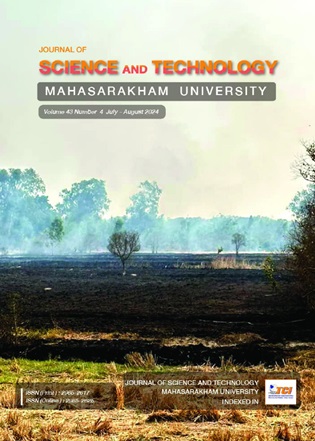Antibacterial activities of formulated plant ethanolic extracts and application in liquid soap products
Main Article Content
Abstract
Many plant extracts are more effective against Gram-positive bacteria than Gram-negative bacteria. This research aimed to develop a plant extract formula with antibacterial activity against both Gram-positive and Gram-negative bacteria. Four distinct plant species, namely leaves of Tectona grandis L.f., rhizomes of Zingiber purpureum Roscoe, rhizomes of Curcuma longa L., and fruits of Carissa carandas L., were extracted using 95% ethanol. A total of 15 different extract formulations were prepared and subsequently evaluated for their antibacterial efficacy against Staphylococcus aureus ATCC 29213 and Escherichia coli ATCC 25922 using agar disc diffusion and broth microdilution methods. The most promising formulation was further assessed against eight strains of both Gram-positive and Gram-negative bacteria. Additionally, the selected formulation was incorporated into a liquid soap, and its efficacy in reducing bacterial cell counts was investigated. The results demonstrated that the fourth formulation exhibited superior antibacterial activity with minimum inhibitory concentration (MIC) values ranging from 0.6 to 2.5 mg/ml against Gram-positive bacteria and 5.0 to 10.0 mg/ml against Gram-negative bacteria. Minimum bactericidal concentration (MBC) values of the formula against Gram-positive bacteria ranged from 2.5 to 10.0 mg/ml, while for Gram-negative bacteria, MBC values ranged from 10.0 to 20.0 mg/ml. This study also revealed that the liquid soap containing the extract formulation effectively reduced bacterial cell counts for both Gram-positive and Gram-negative bacteria. In conclusion, this study highlights the efficacy of the extract formula in combating a wide spectrum of bacterial infections.
Article Details
References
มณฑล วิสุทธิ. (2017). ฤทธิ์ต้านแบคทีเรียกลุ่ม Staphylococci ของสารสกัดจากพืชท้องถิ่นบางชนิดในจังหวัดนครราชสีมา. KKU Science Journal, 45(4), 805-816.
มณฑล วิสุทธิ. (2019). Formulation of plant extracts for some pathogenic bacteria inhibition. Progress in Applied Science and Technology, 9(2), 125-135.
Candra, D. H., Eka, S. P., & Sinta, W. U. (2019). Acute toxicity of Indonesian natural food colorant Tectona grandis leaf extract in Wistar rats. Journal of Medical Sciences, 19, 69-74.
Cieplik, F., Jakubovics, N. S., Buchalla, W., Maisch, T., Hellwig, E., & Al-Ahmad, A. (2019). Resistance toward chlorhexidine in oral bacteria–is there cause for concern?. Frontiers in Microbiology, 10, 587.
Gonzalez, N., Sevillano, D., Alou, L., Cafini, F., Gimenez, M. J., Gomez-Lus, M. L., Prieto, J. & Aguilar, L. (2013). Influence of the MBC/MIC ratio on the antibacterial activity of vancomycin versus linezolid against methicillin-resistant Staphylococcus aureus isolates in a pharmacodynamic model simulating serum and soft tissue interstitial fluid concentrations reported in diabetic patients. Journal of Antimicrobial Chemotherapy, 68(10), 2291-2295.
Jampa, O., Panthong, S., & Itharat, A. (2019). Phytochemical constituents, anti-microbial, anti-inflammatory and cytotoxic activities of Carissa carandas L. fruit and seed extracts. Thammasat Medical Journal, 19(4), 654-666.
Kazimoto, T., Abdulla, S., Bategereza, L., Juma, O., Mhimbira, F., Weisser, M., Utzinger, J., von Müller, L., & Becker, S. L. (2018). Causative agents and antimicrobial resistance patterns of human skin and soft tissue infections in Bagamoyo, Tanzania. Acta tropica, 186, 102-106.
Koontongkaew, S., Poachanukoon, O., Sireeratawong, S., Dechatiwongse Na Ayudhya, T., Khonsung, P., Jaijoy, K., Soawakontha, R., & Chanchai, M. (2014). Safety evaluation of Zingiber cassumunar Roxb. rhizome extract: acute and chronic toxicity studies in rats. International Scholarly Research Notices, 2014,632608.
Lachapelle, J. M., Castel, O., Casado, A. F., Leroy, B., Micali, G., Tennstedt, D., & Lambert, J. (2013). Antiseptics in the era of bacterial resistance: a focus on povidone iodine. Clinical Practice, 10(5), 579.
Misic, A. M., Gardner, S. E., & Grice, E. A. (2014). The wound microbiome: modern approaches to examining the role of microorganisms in impaired chronic wound healing. Advances in wound care, 3(7), 502-510.
Neimkhum, W., Anuchapreeda, S., Lin, W. C., Lue, S. C., Lee, K. H., & Chaiyana, W. (2021). Effects of Carissa carandas Linn. Fruit, pulp, leaf, and seed on oxidation, inflammation, tyrosinase, matrix metalloproteinase, elastase, and hyaluronidase inhibition. Antioxidants, 10(9), 1345.
Niamsa, N., & Sittiwet, C. (2009). Antimicrobial activity of Curcuma longa aqueous extract. Journal of Pharmacology and Toxicology, 4(4), 173-177.
Prajuabjinda, O., Panthong, S., & Itharat, A. (2012). Antimicrobial activity of Thai medicinal preparation of Khampramong Temple used for cancer treatment and its plant components. Journal of the Medical Association of Thailand, 95, S159-65.
Soleimani, V., Sahebkar, A., & Hosseinzadeh, H. (2018). Turmeric (Curcuma longa) and its major constituent (curcumin) as nontoxic and safe substances. Phytotherapy Research, 32(6), 985-995.
Taechowisan, T., Suttichokthanakorn, S., & Phutdhawong, W. S. (2018). Antibacterial and cytotoxicity activities of phenylbutanoids from Zingiber cassumunar Roxb. Journal of Applied Pharmaceutical Science, 8(7), 121-127.
Temrangsee, P., Kondo, S., & Itharat, A. (2011). Antibacterial activity of extracts from five medicinal plants and their formula against bacteria that cause chronic wound infection. Journal of the Medical Association of Thailand, 94, S166-71.
Visutthi, M. (2016). Anti-bacterial and anti-quorum sensing properties of selected medicinal plants from Nakhon Ratchasima Province, Thailand. Progress in Applied Science and Technology, 6(1), 1-13.


